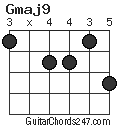-
My instructor gave me this chord shape to use for G Major 9. He uses his fingers but I want to strum the chord.
How would you mute that 5th string. I can do it by putting an arch in my barre chord finger at the 5th string but it seems troublesome. I am betting you seasoned Jazz guys probably avoid this chord shape altogether or have developed a solid technique to be able to strum it and mute it well.
Can you help me resolve this dilemma?
-
07-21-2012 01:01 PM
-
I have been messing with this and I think I just about have it down. I hop eI can get it done "at speed."
 Originally Posted by AlsoRan
Originally Posted by AlsoRan
I am aware that finger muting is a skill that needs to be learned along with everything else.
-
What's the shape? I'm assuming 3 x 4 2 3 x?
I just let the underside of my middle finger that's fretting the low G do the work...
Oh, barre chord...is he playing five notes? Too much.
-
I try to cover the F# and B with the 3rd finger
1x3324
or you could use your thumb
Tx2314
-
Here is the shape:

-
Bingo! The thumb did the trick!
 Originally Posted by JohnW400
Originally Posted by JohnW400
-
I know, Mr. B.
 Originally Posted by mr. beaumont
Originally Posted by mr. beaumont
I have not forgotten what Brownhornet and Jake A taught about using less notes.
But I am doing that little walking bass thing and I need those lower roots, and I also want the top note for some chord melody I am brewing.
Thanks for the reminder. I won't even worry about the sixth string when I have someone else playing the root.
See what hanging around this forum can do?
Last edited by AlsoRan; 07-21-2012 at 09:33 PM. Reason: punctuation
-
Sometimes in a pinch all you need is the GxF#xDA (1x3x24) The listeners ear will fill in the B
-
I'd probably choose 3x4455 instead. Gmaj13. Easier to grab, and an extra colour tone. Fourths sound on the top strings too.
-
You probably don't need the D on the second string. No barre - no problem.
-
AlsoRan:
JohnW400's idea of using your 3rd finger to take those 4th fret notes, the F# and B, while also muting the 5th string, is reasonably feasible. But I agree with Mr B, we may have too many notes sounding here, unless moving harmony lines are involved. In terms of straightforward harmony, for a Gmaj9, the relative importance of the notes is very roughly this (it depends on the context):
1.- B, because this is what tells the listener it is a major not a minor chord.
2.- F#, because it tells the listener it isn't a dominant chord.
3.- D, because it completes the G triad.
4.- G, because it's the root, but is highly omissible if you have any other bass lines going on.
5.- A, in the unlikely event that it isn't going to be sounded by a melody instrument/singer, in which case it is totally omissible.
I'd accept lots of arguments against this ranking, but what I would insist on is that the B is almost always more significant than the D, it gives the ear more useful information. So I'd tend to agree with ColinO, omit the D on the 2nd string, which doesn't actually contribute much anyway.
-
+1
 Originally Posted by GodinFan
Originally Posted by GodinFan
Was going to suggest this. First finger playing the root on the 6th string will also mute the open A (5th string), so good for strumming or fingerpicking.
Also, who wants a 5th in their maj9 chord anyway? What did a 5th ever do for you?
-
Get me drunk.
 Originally Posted by Sharks
Originally Posted by Sharks
-
Thanks to you all.
You have given me yet another another couple of ways to look at chord construction and the importance, or lack of importance, of each degree in a chord.
-
I catch the D & G strings as a double-stop with 3rd finger. Index finger on 6th string and the back of the index finger muting the 5th string. 2nd finger is handling the 2nd string. Pinky is getting 1st string. This way I can move the index finger a half-step for bass line if I want.
-
I agree with the others that it's kind of pointless to play this voicing in a jazz context. That being said, it's super easy to mute the 5th string using the tip of your second finger.
 Originally Posted by AlsoRan
Originally Posted by AlsoRan




 Reply With Quote
Reply With Quote







2 new & excellent Jazz Comping Truefire...
Today, 10:22 PM in Comping, Chords & Chord Progressions